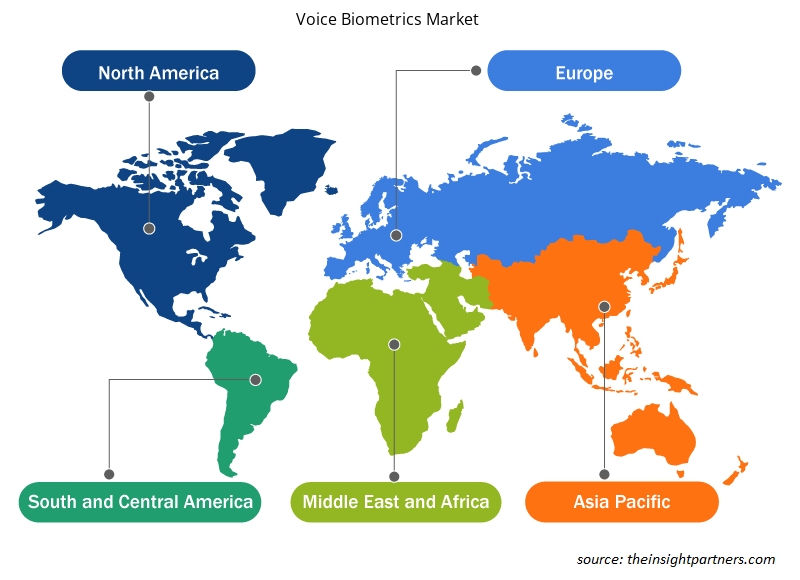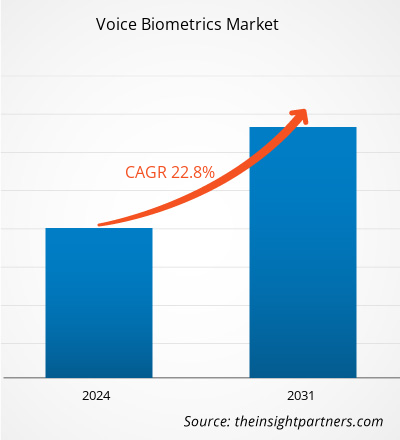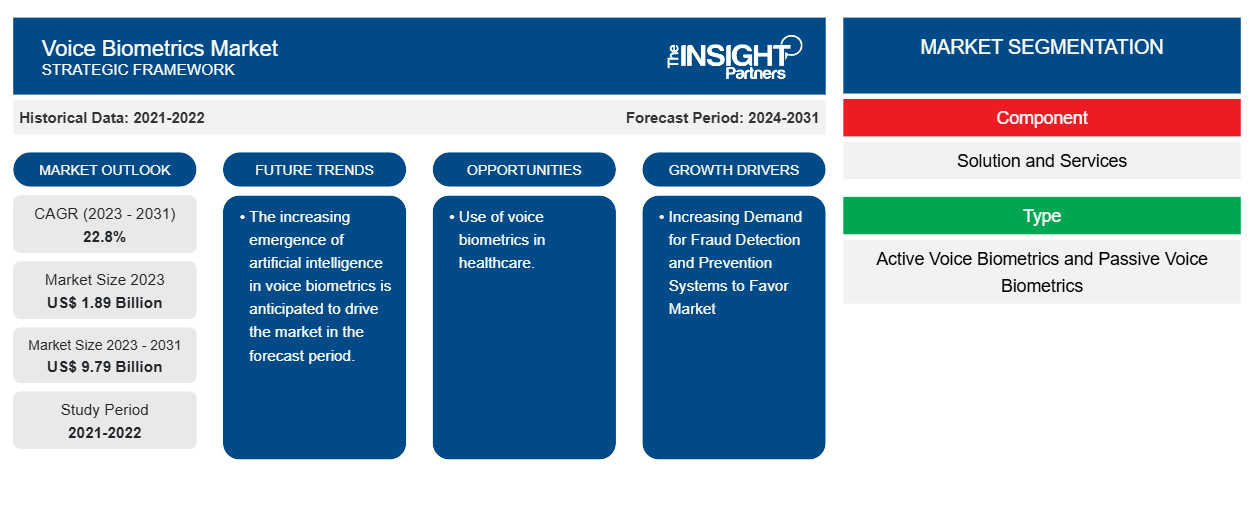Le marché de la biométrie vocale devrait atteindre 9,79 milliards de dollars d'ici 2031, contre 1,89 milliard de dollars en 2023. Le marché devrait enregistrer un TCAC de 22,8 % au cours de la période 2023-2031. La demande croissante de systèmes de détection et de prévention de la fraude et la demande croissante d'authentification vocale dans les applications mobiles et bancaires devraient rester des tendances et des moteurs clés du marché.
Analyse du marché de la biométrie vocale
Le marché de l’analyse du marché de la biométrie vocale gagne considérablement du terrain. Cette croissance est attribuée au développement du système de détection et de prévention et à la demande croissante d’authentification vocale dans les applications bancaires mobiles. De plus, l’adoption croissante de la biométrie vocale dans le secteur de la santé et l’émergence croissante de l’IA dans la biométrie vocale devraient offrir diverses opportunités sur le marché de la biométrie vocale.
Aperçu du marché de la biométrie vocale
La technologie de biométrie vocale valide l'identité d'un locuteur. Elle est également connue sous le nom de reconnaissance vocale, reconnaissance du locuteur, empreinte vocale et authentification vocale. La reconnaissance vocale automatisée (ASR) est un aspect clé des technologies telles que la réponse vocale interactive , les assistants virtuels, les services de divertissement et d'urgence embarqués, la téléphonie mobile (par exemple, les smartphones) et l'informatique. La technologie identifie les mots prononcés par un locuteur afin qu'une application puisse en faire quelque chose.
Personnalisez ce rapport en fonction de vos besoins
Vous bénéficierez d'une personnalisation gratuite de n'importe quel rapport, y compris de certaines parties de ce rapport, d'une analyse au niveau des pays, d'un pack de données Excel, ainsi que de superbes offres et réductions pour les start-ups et les universités.
-
Obtenez les principales tendances clés du marché de ce rapport.Cet échantillon GRATUIT comprendra une analyse de données, allant des tendances du marché aux estimations et prévisions.
Moteurs et opportunités du marché de la biométrie vocale
La demande croissante de systèmes de détection et de prévention de la fraude favorise le marché
La demande croissante de systèmes de détection et de prévention des fraudes stimule le marché de la biométrie vocale. Les analyses de détection et de prévention des fraudes s'appuient sur l'exploration de données et l'apprentissage automatique et sont utilisées dans des cas d'utilisation d'analyse des fraudes tels que l'analyse des fraudes financières, l'analyse des fraudes de paiement et l'analyse de détection des fraudes d'assurance. De plus, à mesure que les pirates informatiques développent des moyens plus avancés pour commettre des fraudes téléphoniques, les organisations de tous les secteurs doivent renforcer leurs mesures de sécurité pour détecter et dissuader la menace. Avec la biométrie vocale, comme la reconnaissance vocale automatisée, fournir un moyen convaincant de protéger les clients doit faire partie de la future lutte contre la fraude. Ainsi, compte tenu des paramètres ci-dessus, la demande croissante de systèmes de détection et de prévention des fraudes stimule le marché de la biométrie vocale.
Utilisation de la biométrie vocale dans les soins de santé.
Le secteur de la santé est l'un des secteurs qui connaît la croissance la plus rapide au monde. C'est également l'un des secteurs les plus exigeants en matière de sécurité biométrique. Le secteur de la santé a rencontré de nombreux problèmes en raison de l'augmentation des cas de fraude et de vol d'identité. La biométrie vocale est une solution absolue pour le secteur de la santé pour surmonter ces défis car elle offre une grande précision et une grande facilité d'utilisation. Ainsi, la biométrie vocale dans le secteur de la santé n'a fait qu'augmenter en demande au cours des dernières années.
Analyse de segmentation du rapport sur le marché de la biométrie vocale
Les segments clés qui ont contribué à l’élaboration de l’analyse du marché de la biométrie vocale sont les composants, le type, le processus d’authentification, le déploiement, le secteur vertical et l’application.
- En fonction des composants, le marché de la biométrie vocale est divisé en solutions et services. Le segment des solutions devrait détenir une part de marché importante au cours de la période de prévision.
- En fonction du type, le marché de la biométrie vocale est divisé en biométrie vocale active et biométrie vocale passive. Le segment du durcissement des radiations par conception (RHBD) devrait détenir une part de marché importante au cours de la période de prévision.
- En termes de processus d'authentification, le marché est segmenté en IVR automatisé, assisté par agent, application mobile et authentification des employés. Le segment IVR automatisé devrait détenir une part de marché importante au cours de la période de prévision.
- En termes de déploiement, le marché est segmenté en cloud et sur site. Le segment cloud devrait détenir une part de marché significative au cours de la période de prévision.
- Le marché est segmenté en BFSI, commerce de détail et de détail , gouvernement et défense, informatique et télécommunications, santé et sciences de la vie, transport et logistique, voyages et hôtellerie, énergie et services publics, etc. Le segment BFSI devrait détenir une part de marché significative au cours de la période de prévision.
- En termes d'application, le marché est segmenté en authentification et vérification des clients, analyse vocale médico-légale et enquête criminelle, détection et prévention des fraudes, gestion des risques et des urgences, traitement des transactions, contrôle d'accès, gestion des effectifs, etc. Le segment de l'authentification et de la vérification des clients devrait détenir une part de marché importante au cours de la période de prévision.
Analyse des parts de marché de la biométrie vocale par zone géographique
La portée géographique du rapport sur le marché de la biométrie vocale est principalement divisée en cinq régions : Amérique du Nord, Asie-Pacifique, Europe, Moyen-Orient et Afrique, et Amérique du Sud et centrale.
L'Amérique du Nord domine le marché de la biométrie vocale. Les tendances d'adoption de haute technologie dans diverses industries de la région nord-américaine ont alimenté la croissance du marché de la biométrie vocale. Des facteurs tels que l'adoption accrue d'outils numériques et les dépenses technologiques élevées des agences gouvernementales devraient stimuler la croissance du marché nord-américain de la biométrie vocale. De plus, l'accent mis sur la recherche et le développement dans les économies développées des États-Unis et du Canada oblige les acteurs nord-américains à introduire des solutions technologiquement avancées sur le marché. En outre, les États-Unis comptent un grand nombre d'acteurs du marché de la biométrie vocale qui se concentrent de plus en plus sur le développement de solutions innovantes. Tous ces facteurs contribuent à la croissance du marché de la biométrie vocale dans la région.
Aperçu régional du marché de la biométrie vocale
Les tendances et facteurs régionaux influençant le marché de la biométrie vocale tout au long de la période de prévision ont été expliqués en détail par les analystes d’Insight Partners. Cette section traite également des segments et de la géographie du marché de la biométrie vocale en Amérique du Nord, en Europe, en Asie-Pacifique, au Moyen-Orient et en Afrique, ainsi qu’en Amérique du Sud et en Amérique centrale.

- Obtenez les données régionales spécifiques au marché de la biométrie vocale
Portée du rapport sur le marché de la biométrie vocale
| Attribut de rapport | Détails |
|---|---|
| Taille du marché en 2023 | 1,89 milliard de dollars américains |
| Taille du marché d'ici 2031 | 9,79 milliards de dollars américains |
| Taux de croissance annuel composé mondial (2023-2031) | 22,8% |
| Données historiques | 2021-2022 |
| Période de prévision | 2024-2031 |
| Segments couverts |
Par composant
|
| Régions et pays couverts |
Amérique du Nord
|
| Leaders du marché et profils d'entreprises clés |
|
Densité des acteurs du marché de la biométrie vocale : comprendre son impact sur la dynamique des entreprises
Le marché de la biométrie vocale connaît une croissance rapide, tirée par la demande croissante des utilisateurs finaux en raison de facteurs tels que l'évolution des préférences des consommateurs, les avancées technologiques et une plus grande sensibilisation aux avantages du produit. À mesure que la demande augmente, les entreprises élargissent leurs offres, innovent pour répondre aux besoins des consommateurs et capitalisent sur les tendances émergentes, ce qui alimente davantage la croissance du marché.
La densité des acteurs du marché fait référence à la répartition des entreprises ou des sociétés opérant sur un marché ou un secteur particulier. Elle indique le nombre de concurrents (acteurs du marché) présents sur un marché donné par rapport à sa taille ou à sa valeur marchande totale.
Les principales entreprises opérant sur le marché de la biométrie vocale sont :
- Aculab
- Auraya, Inc
- Conscient Inc.
- Nuance Communications, Inc.
- NICE Ltée
- Goutte d'eau
Avis de non-responsabilité : les sociétés répertoriées ci-dessus ne sont pas classées dans un ordre particulier.

- Obtenez un aperçu des principaux acteurs du marché de la biométrie vocale
Actualités et développements récents du marché de la biométrie vocale
Le marché de la biométrie vocale est évalué en collectant des données qualitatives et quantitatives après des recherches primaires et secondaires, qui comprennent d'importantes publications d'entreprise, des données d'association et des bases de données. Quelques-uns des développements du marché de la biométrie vocale sont énumérés ci-dessous :
- Bank of Ireland a annoncé un investissement de plus de 36 millions de dollars pour moderniser ses systèmes téléphoniques et CRM, notamment en ajoutant la biométrie vocale pour l'authentification. L'utilisation de la biométrie vocale améliorera la protection contre la fraude et réduira les temps d'attente des clients. Cet investissement fait suite à une annonce de 64 millions de dollars pour les distributeurs automatiques de billets et les réseaux d'agences et de 54 millions de dollars pour la protection contre la fraude. (Source : Bank of Ireland, communiqué de presse, mai 2024)
- City Union Bank Limited (CUB) a lancé une nouvelle fonctionnalité qui permet aux clients d'utiliser l'authentification biométrique vocale lors de la connexion à l'application bancaire mobile de la banque, dans le but d'améliorer la sécurité. La banque a prévu d'étendre également cette fonctionnalité aux utilisateurs de services bancaires en ligne, et le processus de développement est actuellement en cours. (Source : City Union Bank Limited, communiqué de presse, avril 2023).
Rapport sur le marché de la biométrie vocale : couverture et livrables
Le rapport « Taille et prévisions du marché de la biométrie vocale (2021-2031) » fournit une analyse détaillée du marché couvrant les domaines ci-dessous :
- Taille et prévisions du marché de la biométrie vocale aux niveaux mondial, régional et national pour tous les segments de marché clés couverts par le périmètre
- Tendances du marché de la biométrie vocale ainsi que dynamique du marché telles que les facteurs déterminants, les contraintes et les opportunités clés
- Analyse détaillée des cinq forces de PEST/Porter et SWOT
- Analyse du marché de la biométrie vocale couvrant les principales tendances du marché, le cadre mondial et régional, les principaux acteurs, les réglementations et les développements récents du marché
- Analyse du paysage industriel et de la concurrence couvrant la concentration du marché, l'analyse de la carte thermique, les principaux acteurs et les développements récents pour le marché de la biométrie vocale
- Profils d'entreprise détaillés
- Analyse historique (2 ans), année de base, prévision (7 ans) avec TCAC
- Analyse PEST et SWOT
- Taille du marché Valeur / Volume - Mondial, Régional, Pays
- Industrie et paysage concurrentiel
- Ensemble de données Excel
Rapports récents
Rapports connexes
Témoignages
Raison d'acheter
- Prise de décision éclairée
- Compréhension de la dynamique du marché
- Analyse concurrentielle
- Connaissances clients
- Prévisions de marché
- Atténuation des risques
- Planification stratégique
- Justification des investissements
- Identification des marchés émergents
- Amélioration des stratégies marketing
- Amélioration de l'efficacité opérationnelle
- Alignement sur les tendances réglementaires























 Obtenez un échantillon gratuit pour - Marché de la biométrie vocale
Obtenez un échantillon gratuit pour - Marché de la biométrie vocale